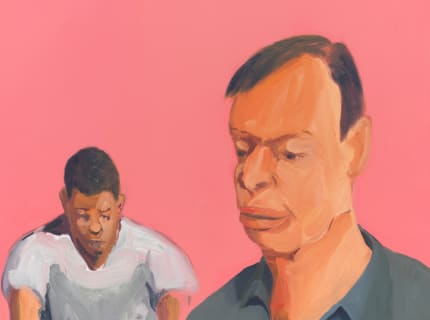Steve Locke’s work bears witness to the specificity of American racialized violence. In “the fire next time” (on view through November 8, 2025), he asks viewers to stand with him in this role of witness and to think about what it really means. It’s easy to default to a legal framework, forgetting that the role of witness has ancient roots in collective building, from culture and history to community and liberation.
At the entrance to the exhibition’s main gallery, A Partial List of Unarmed African-Americans Who Were Killed by Police or Who Died in Police Custody During My Sabbatical from Massachusetts College of Art and Design, 2014-2015 (2016) provides the first instance of bearing witness. Locke, for his part in this communal act, installed a neon blue sign reading “a dream.” Below this, a spreadsheet-style list of 262 names covers two walls. As the title states, these Black Americans were killed by police or died in police custody. The work offers a straightforward delivery of facts: date, name, sex, age, location, manner of death. This is the first step in the role of witness—the facts. There is variety in some of the columns, especially the victims’ ages. But the manner of their deaths is repetitious—gunshot, gunshot, gunshot, tasered, tasered, gunshot, vehicle, gunshot. The effect is nauseating, no conjecture needed.
The repetition is meant to endure through our role as viewers-turned-witnesses: read the names, repeat them, remember them. Who and what did they leave in the wake of the institutional violence that ended their lives?
Locke may be acting as witness, but he is also an artist. The work’s interpretive moment occurs in the neon words, “a dream,” which hover over the list of the dead. Which dream, and who gets to dream this dream? Of course, the 262 people killed had dreams, and if the dead dream it’s surely of living, and very likely of justice. Inevitably, Martin Luther King, Jr.’s iconic, visionary “I Have a Dream” speech comes to mind, but it is a poor fit for this context. The exhibition title—“the fire next time”—comes from James Baldwin’s book of the same name. Baldwin, too, operated as a witness; but as a writer, he also had a strong point of view and interpreted the world he was witnessing and experiencing as a Black man in the mid- to late-20th century. Baldwin’s writing is deeply critical of the American dream (and the structures and institutions that uphold/withhold it) because it is not a dream easily accessed by Black Americans, if at all. It is worth noting that it has been 62 years since King gave his speech and Baldwin published The Fire Next Time.
...
Read full article at sculpturemagazine.art

